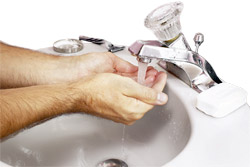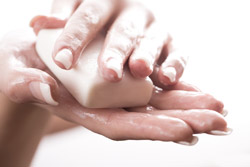- Why is handwashing so important?
- Correct handwashing technique with soap and water
- Washing with antimicrobial soap
- Other tips for keeping hands hygienic
Why is hand washing so important?
Regularly washing your hands is an important measure for preventing the spread of germs which cause diseases. In most situations, washing your hands with soap and water according to the correct technique, is enough to leave them hygienically clean. However, many people do not wash their hands properly, even if they do use soap and water. It’s important to be familiar with the correct technique so you know how to remove germs effectively each time you wash.
Correct hand washing technique with soap and water
To wash your hands correctly:
- Before washing hands, remove rings as well as jewellery like bangles you wear on your wrists. Plain rings can be left on, but you should remove all other jewelry, including your wristwatch;
- Ensure any cuts on your hands or wrists are covered with a waterproof dressing like a plaster (band-aid);
- Wet your hands thoroughly with water. Either hot or cold water can be used as evidence suggests that they are equally effective for removing germs from the hands;
- Apply liquid or bar soap to your hands. Use enough soap so that it creates a thick lather over your hands when you rub them together. If using an alcohol based wash instead of soap and water, you’ll need a palmful to wash your hands properly;
- Rub your hands together to lather the soap. While lathering move your hands away from the running water to ensure the soap is not washed away before it has time to wash away the germs on your hands. This is important as the soapy lather works to suspend dirt and germs so they can be easily washed away. Lather the back and front of your hands, your wrists and your fingernails, ensuring you don’t miss any spots. Commonly missed spots include finger tips, between fingers, thumbs and wrists;
- Wash all parts of your hands thoroughly for 15-20 seconds;
- Rinse your hands thoroughly under running water so the germs wash away. Do not use a bowl of stagnant water for rinsing. Keep your hands down to ensure that the contaminated rinse water drains down the sink and does not run up your wrists and elbows;
- If the tap needs to be turned off manually, cover your hand with a disposable paper towel to turn off the tap. This helps prevent your hands from being re-contaminated with germs on the tap.
Get on top of your general health
Find and instantly book affordable GPs within Australia
It is also important to thoroughly dry your hands after each wash, as wet hands are more likely to pick up germs from the environment. The best way to dry your hands is to:
- Use a disposable paper towel;
- Pat your hands dry, don’t rub them. Rubbing your hands can cause skin damage;
- Do not use a multiple use towel as the towel may harbor germs which can re-contaminate your hands;
- Hot air dryers which are commonly found in public toilets may also be used to dry your hands. However, they are not recommended if you work in healthcare settings such as a hospital, unless their design has been proven to prevent the spread of germs.
The hand washing procedure should take 40-60 seconds.
Washing with antimicrobial soap
If you are a nurse, doctor or other healthcare professionals, you may need to wash your hands with antimicrobial soap before touching a patient. To wash with antimicrobial soap you should follow the above steps, but use a soap with antimicrobial activity instead of normal soap. You will need to lather and wash your hands with the anti-microbial soap for 60 seconds (not 15-20 seconds as per the standard procedure).
Other tips for keeping hands hygienic
Other tips which may help ensure your hands are hygienic include:
- Keep your finger nails short and clean. Artificial or long fingernails make hand hygiene difficult because dirt and germs get caught under the fingernails. Ideally nails should be trimmed to <0.5 cm long so that soap can get under the nails during hand washing;
- If you use sponges or clothes for washing your hands they must be washed frequently with bleach. Clothes and sponges provide moist surfaces, ideal for the growth of micro-organisms.
References
- South Australian Health Infection Prevention and Control. Hand Hygiene Guideline. 2010. [cited 4 August 2013]. Available from: [URL Link]
- Utah Department of Health. Hand Washing Information. 2005. [cited 22 Feb 2011]. Available from: [URL Link]
- World Alliance for Patient Safety. WHO Guidelines on hand hygiene in healthcare (Advanced Draft)- a Summary- Clean hands are safer hands. 2005. [cited 2 March 2011]. Available from: [URL Link]
- National Health and Medical Research Council. Handwashing. In Preventing Infectious Diseases in Childcare. 4th Ed. 2006. [cited 22 Feb 2011]. Available from: [URL Link]
- Clinical Excellence Commission. Hand hygiene with artificial nails and wrist jewellery. 2006. [cited 20 August 2013]. Available from: [URL Link]
All content and media on the HealthEngine Blog is created and published online for informational purposes only. It is not intended to be a substitute for professional medical advice and should not be relied on as health or personal advice. Always seek the guidance of your doctor or other qualified health professional with any questions you may have regarding your health or a medical condition. Never disregard the advice of a medical professional, or delay in seeking it because of something you have read on this Website. If you think you may have a medical emergency, call your doctor, go to the nearest hospital emergency department, or call the emergency services immediately.









